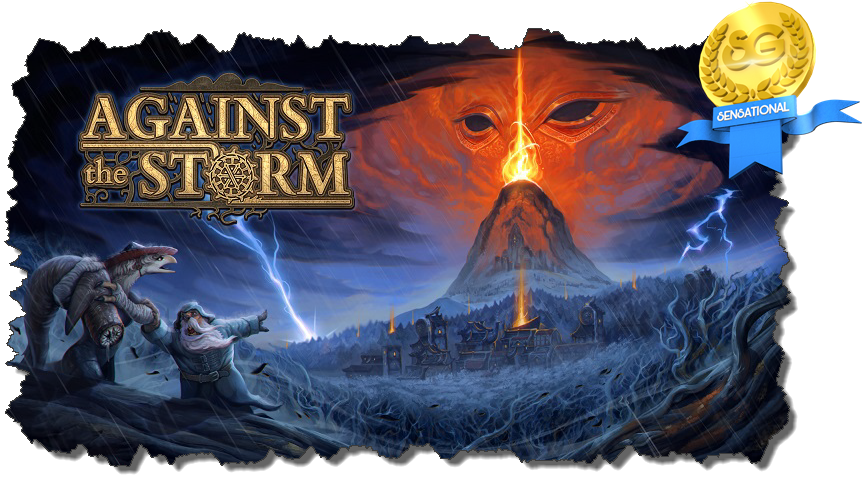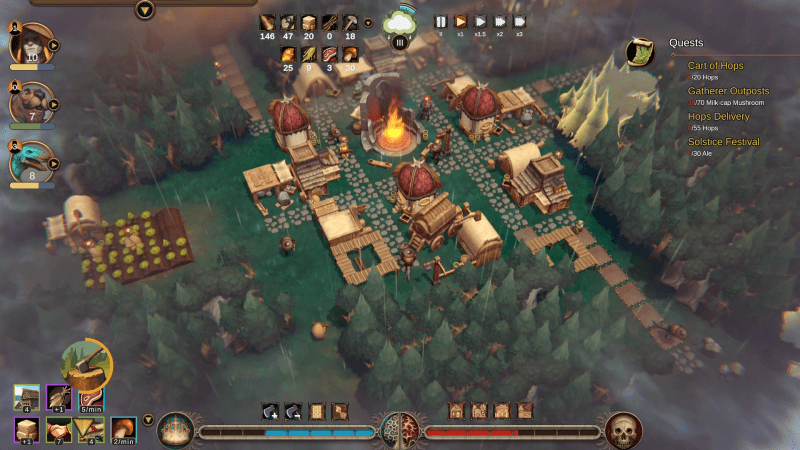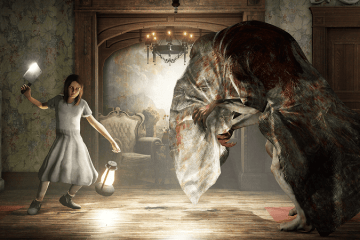You can find Seasoned Gaming’s review policy here
Eremite Games’ Against the Storm is a unique game that takes two seemingly incompatible genres and creates a hybrid game that not just works, but is surprisingly fun and beautiful; Against the Storm is part rogue-lite and part city builder. This is a seemingly impossible mix of game genres. Rogue-lites require multiple, short (usually) runs that result in a victory or a death with the entire point being to get some sort of upgrade or unlock which, hopefully, makes your next attempt easier. City Builders are typically more focused on persistence, starting a city or civilization from nothing to see if it grows, thrives, and overcomes obstacles. So how does Against the Storm meld these genres into something new and unique?
The main goal in Against the Storm is to build up and restore a central city, called the Smoldering City. Restoring the Smoldering City is done by building up smaller satellite towns to collect resources and unlock different bonuses. This is where the rogue-lite elements come into play as each town that is built is the equivalent of a “run” in a more traditional rogue-lite game. Each time you successfully create a new town, it will be a permanent fixture on the world map. These towns will still be very important even after the run where it was completed. The individual towns can trade amongst each other and help support other towns and the Smoldering City.
So what does the rogue-lite loop look like in Against the Storm? From the world map you can select a location for your city, and the surrounding nodes will influence what the city area looks like in terms of landscape and resource availability. There can be starting locations with higher concentrations of wood or stone based on this location choice. From my playthroughs in the beginning of the game, the exact location had little impact on my ability to successfully complete the town and have it set up permanently. Your town will start with a basic structure: the central hearth. This building is the center piece to each town, and keeping it lit and running is crucial to the survival of the town.
Your new town will also have a small group of citizens split between the game’s three races; human, beaver, and lizardman. Each race has a variety of skills they excel at and preferences for events, food, housing, etc. This is the very first layer in Against the Storm’s very deep management system. The core building gameplay from here will feel very familiar if you’ve ever played a building game like Warcraft 3, for example. You can build basic structures, like woodcutter’s camps to cut down trees, stonecutter’s camps for stone, clay, and roots, and various other camps to harvest and collect other resources like eggs, herbs, meat, insects, and berries. Each of these camps has a range, and only resource nodes within the range will be harvested. While this sounds like a bad thing and will require lots and lots of buildings to be purchased, it’s implemented very well in the game.
Each building can be picked up and moved, so when one area is emptied, you can simply move the buildings around. Between the portable buildings and the ability to build paths and roads for your citizens, you are given a lot of freedom to make your town as efficient as possible. Each building also requires citizens to be assigned to them; your woodcutter will not cut any wood if there are no people to cut the wood. Each building has several slots, and while some require a specific race to be assigned, others are open to any of the three. I will go deeper into the races in a little bit.
Once you have your collection buildings, you need something to do with those resources, right? There are two types of buildings that can utilize the resources production and service buildings. Production buildings are straight forward: they take in the raw resources and convert them into more advanced products. For example, raw wood gets turned into planks, and the planks can get turned into other products or used for the advanced buildings.

Looking at the service buildings, we can start to discuss the traits and mechanics behind the individual citizens of your town. I’ve already discussed the three different races and how they can impact buildings and resource production, but let’s look a little closer into the races. Each race has traits and perks that can affect their productivity and, most importantly, their resolve. While individual citizens don’t have their own resolve meters, each race does. All humans in your town have a group resolve score, as do the beavers and lizardmen. Resolve is vitally important to the success of your town, and many things can make it go up or down. Simple things like having housing for your citizens or the current weather season (more on this in a little bit), and more complicated race-specific events can trigger resolve changes. If a race’s resolve is high, they are less likely to be negatively impacted during the negative events or more difficult seasons. If a race’s resolve drops too low, they can refuse to work, or simply leave your town, which can be devastating.
One event I ran into a few times was finding a group of dead hunters. Whichever race the dead hunters belong to will be hit with a large resolve penalty until the event is cleared up. Like most events in this game, there are multiple ways to handle them. This event can be dealt with by carrying the bodies back to your city center and giving them a proper funeral, or you can loot the bodies for resources. There are pros and cons to each decision, and it’s these sometimes very tough choices that will make or break your town.
One part of the rogue-lite recipe is that there must be some sort of exploration and “item” mechanic, and while you don’t collect items in the traditional sense, there are exploration bonuses that can trigger positive or negative events. When you start a new town, a very small portion of the map is revealed, and you will notice that there are foggy openings called glades surrounding your area. These glades are the equivalent of an item room in a traditional rogue-lite. When you build your woodcutter’s camps, you can pick the specific trees that you would like to harvest so you can choose which glades to open.
Glades can contain anything, from resource nodes to abandoned buildings, or even events like the dead hunters I previously mentioned. Every map will also have a handful of either dangerous or forbidden glades, which can present great peril to your town and the citizens. Even though these events can be dangerous, a well prepared town can handle them quickly and reap some fantastic rewards. Most of the dangerous or forbidden glades will have timers on the events, so your citizens will have to mobilize quickly to mitigate the risk.

So how does one “win” a run or create the permanent town? The main bars you’ll see at the bottom of your screen are for your reputation and the queen’s impatience. If her impatience maxes at 10 then it’s game over for that community, and if your reputation gets to 10, you win. This entire game is a balancing act, and almost every decision you make will have a positive benefit at the cost of something else. Are you willing to build up your reputation at the cost of your citizen’s happiness?
Throughout the game you will get orders to complete. These orders will typically give you a reputation boost and reduce the queen’s impatience while providing a reward of resources. You have freedom to pick between two orders, so it’s not too difficult to pick orders that your community can fulfill. The orders will range from delivering a certain number of products, having specific citizens, or opening a certain number of glades. As you increase your reputation, you will unlock more order slots, so you’ll have the ability to complete more concurrently. One of the most important things to do to keep your reputation moving in a positive direction is to keep your citizens happy and keep their resolve level high. If you look at Lizardmen, for example, they prefer warm/dry weather, prefer food like jerky and other meat products, and they like working in buildings that are warm, like the town’s central hearth.

Other luxury items, like raincoats, can provide a boost across all your citizens. Your happy citizens will produce faster, and they’ll generate reputation faster as well. The one thing that the impatience mechanic really does is to force you to be continually improving your town. When playing other builder games, it is very possible to stall to stockpile resources and just build up your town with little repercussions, but Against the Storm shuts this tactic down.
There’s a word that’s been floating around this review a lot that hasn’t been addressed yet, and that’s the “storm.” What is the storm, and why are you fighting against it? The Blightstorm batters the land with never-ending rain. There are periods, or seasons, of lower rain where resolve can be restored, and farms can plant crops to help store food for the coming wet season. As previously mentioned, there are modifiers to each run, and those are closely tied in with the season and the weather. My very first run after the tutorial provided me with a card where any wood harvested during the wet season had a percent chance to be rotten and provide no yield at all. This is where the true beauty of Against the Storm shines: you can choose to focus on stockpiling wood during the better seasons and then focus on other production during the wet season, or you can risk harvesting wood with a lower yield.
The Blightstorm will also reshape the world map as you complete runs, so not only does it impact your individual games, but it will force you to rethink your strategy when starting a new game as well. If you manage to go through this entire process and build a successful town, you will earn valuable resources to upgrade the Smoldering City. These upgrades will be vital for your success with your subsequent town building. These upgrades can provide everything from bonuses to production, buffs to troops, and increased orders and rewards.
Mechanically, Against the Storm is a true delight to play, and the presentation enhances the experience beautifully. Graphically, the world is exactly what it needs to be: detailed enough to keep your towns interesting, to tell your citizens apart, and to easily identify the plethora of resources and buildings. The atmospheric elements enhance the mood of the game as well. The fog that covers the glades acts very naturally, and the rain and lighting is very visually impressive. To complete the mood the score fits the environment very well. The music rises and swells alongside the rising tension in the game and quickly becomes more peaceful when the stormy season passes.

In summary, Against the Storm is a truly fantastic game that will appeal to a wide range of people. Fans of 4x games like Civilization will appreciate the depth of the exploration and building, while fans of rogue-lites will appreciate the fresh take at a very trendy genre that is arguably over-inundated with new titles. Even fans of games like Riftworld will appreciate the tactics and complexity that are built into this game. Against the Storm truly shines with the decision that it drops into the player’s lap. Every decision made has a consequence that needs to be taken into consideration before it’s made. Even a simple reward like getting a resource every minute has an opportunity cost of rejecting a higher-risk but higher-reward option.
While there are some basic tactics that will contribute to your success in the game, there’s no one pathway that will always lead to a victory. Many rogue-lites suffer from having a “certain victory” formula, but the hybrid nature of Against the Storm keeps runs fresh while requiring flexibility in tactics and thinking. A single run will take about two hours, and it will take many, many runs to restore the Smoldering City, so a completed game could easily hit triple digits for gameplay time. Thankfully, your progress can be saved at any point during a run so there’s no pressure to finish a run in one session. This game is incredibly well-polished, especially considering that it’s still an early release title and currently only available on the Epic Games Store. But, if it were a full release, it would still receive very high marks. I imagine that there will be some added content and tweaks for balancing out events and penalties, but overall, the game is truly a great experience that I cannot recommend enough. If you don’t want to pull the trigger on a $20 early access title, there is also a demo available which will give you a great feel for the game.




